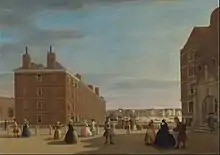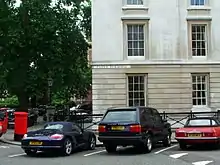Paper Buildings
Paper Buildings are a set of chambers located in the Inner Temple in Temple, London. They were initially constructed in 1609.[1] Paper Buildings appear in A Tale of Two Cities and Barnaby Rudge.[2]


On 6 March 1838, about twenty sets of chambers were destroyed, including some valuable libraries, important documents and so forth. The fire originated in the chambers of W. H. Maule MP.[3]
Paper Buildings are on the site of Heyward's Buildings, constructed in 1610.[4] The "paper" part of the name comes from the fact that they were built from timber, lath and plaster, a construction method known as "paperwork". A fire in 1838 destroyed three of the buildings, which were immediately replaced with a design by Robert Smirke, with Sydney Smirke later adding two more buildings.[5] A famous resident of (at the time) Heyward's Buildings was John Selden, who was one of the original tenants and shared a set of chambers with Heyward himself.[6]
3 Paper Buildings
John Galsworthy had chambers here from November 1894, where he wrote a short story called "Dick Denver's Idea", which was his first work of fiction.[7][8][9][10][11][12] MI5 was located here from 21 February 1911.[13]
3PB (3 Paper Buildings) is a barristers Chambers which has been in existence since Christmas Day 1892. There currently are 152 full-time members, 9 of whom are Queen's Counsel.[14]
References
- Wheatley and Cunningham. "Paper Buildings" in London Past and Present: Its History, Associations, and Traditions. Cambridge University Press. Page 27.
- Stephen Halliday. "The Middle and Inner Temple" in From 221B Baker Street to the Old Curiosity Shop. The History Press. Page 52.
- Cornelius Walford. The Insurance Cyclopeadia. C and E Layton. 1876. Volume 4. pp 77 & 78. Internet Archive.
- Bellot, Hugh (1902). The Inner and Middle Temple, legal, literary, and historic associations. London: Methuen & Co. OCLC 585828. p.69
- "The Buildings". Inner Temple. Retrieved 4 November 2009.
- Bellot, Hugh (1902). The Inner and Middle Temple, legal, literary, and historic associations. London: Methuen & Co. OCLC 585828. p.70
- James Jack Gindin. John Galsworthy's Life and Art. University of Michigan Press. Page 56. Internet Archive
- (1968) 117 New Law Journal 893 Google Books
- Dudley Barker. The Man of Principle: A View of John Galsworthy. Stein & Day. 1963. p 62 Internet Archive.
- Sanford V Sternlicht. John Galsworthy. Twayne Publishers. 1987. p 29. Google Books.
- Alec Fréchet. John Galsworthy: L'Homme, Le Romancier, Le Critique Social. Atelier, reproduced through University of Lille. 1981. p 550. Google Books.
- Dictionary of Literary Biography. Thomson Gale. 2007. (Nobel Prize Laureates in Literature, Part 2) Page 71. Google Books
- West, Nigel. "MI5" in Historical Dictionary of World War I Intelligence. Scarecrow Press. Page 208.
- 3PB
- Britton John. The Original Picture of London. 24th Edition. Longman, Rees, Orme, Brown and Green. Paternoster Row, London. 1826. Page 463.
- Robert Crerar. The Merchant, Tradesman's and Solicitor's Book of Reference. Printed for the author and Basil Steuart. London. 1831. Page 94